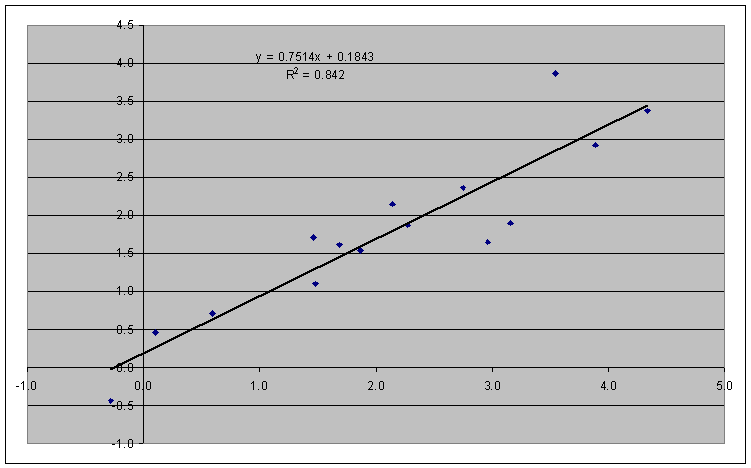Post by eric on Nov 4, 2015 16:12:33 GMT -6
I wanted to make this article as comprehensive and centralized as possible, the idea being you could come in knowing nothing about the software, read it, then know everything as regards attributes without having to look anywhere else.
Ratings and Attributes
Attributes are those quantities we can give +5 to in a skill camp and are not visible to GMs. Ratings are visible to GMs as letter grades and are composed of attributes as follows:
Inside Scoring = 50% Inside Scoring + 30% Strength + 20% Jumping
Outside Scoring = 50% Jump Shot + 50% Three Point Shot
Handling = (67% Passing + 15% Quickness) * (1 + 0.5% * Handling)
Rebounding = 45% Defensive Rebounding + 35% Offensive Rebounding + 15% Strength + 5% Quickness
Defense is roster position dependent as follows:
Any attribute exceeding the roster position's cap will not factor into the player's defensive grade, but will have an impact on the court. When a player changes roster position and gets + or -, this is why. Handling attribute has a notch that treats 61 Handling as 51 Handling for grade calculation purposes, as well as diminishing returns above 61. Again, this does not mean the player has gotten worse, just that grades can be deceiving. Finally, attributes are hard capped for roster positions as follows:
C_: 75 handling, 75 passing, 75 perimeter defense
PF: 80 handling, 80 passing, 75 perimeter defense
SF: none
SG: 60 offensive rebounding, 60 defensive rebounding
PG: 50 offensive rebounding, 50 defensive rebounding, 75 post defense
An attribute cannot exceed a roster position's hard cap either through training camp growth or skill camp / reward camp. However, under certain circumstances a player can be at a different depth chart position than roster position. Only the player's roster position caps apply.
Minimum Rating Needed for Each Grade
The software enforces a minimum rating of 1 and maximum rating of 100, as well as a minimum attribute of 5 and maximum attribute of 100.
Attribute Change over Time
Every player has a hidden and visible potential. Visible potential is calculated after each training camp as hidden potential / 2 + 25 ± 15, with the last term a random range from +15 to -15: 32.5% from +2 to -2, 65% from +14 to +3 and -3 to -14, and 2.5% for +15 and -15. The only value that matters for attribute growth is the hidden potential after training camp. Ending hidden potential from 0 to 20 is tier one, 21 to 40 tier two, and so on to tier five. Here are the maximums for tier 5 per position:
The minimum values are -1 for Jump Shot, -2 for Quickness, Strength, and Jumping, and -5 for everything else. All distributions are symmetrical except for Inside Scoring and Jump Shot, which are skewed down. The only effect of age is that Quickness, Strength, and Jumping will have a -1 applied at age 30+ and an additional -1 applied at age 36+. Quickness, Strength, and Jumping are unaffected by having lower tier growth, as are the minimums for all other attributes.
Hidden potential itself for veterans in their twenties changes from -4 to -7 for hidden potentials from 71 to 100, -7 to -10 from 51 to 70, and +5 to -5 from 1 to 50. For those in their thirties, a -3 is applied. For those in their teens or possibly rookies, only the 71 to 100 range is different with four evenly weighted possibilities:
-decrease of potential / 5
-decrease of between -2 and -6
-stay the same
-increase of between +1 and +20
.
Testing
I check each position from two perspectives.
BAD
-Create a player with fifty less than his position's maximum in every attribute and record eighty seasons.
-Increase one attribute to the maximum and record eighty seasons.
-Return that attribute to fifty less than max, increase the next attribute to the maximum and record eighty seasons.
-Repeat for every attribute.
GOOD
-Create a player with the maximum in every attribute and record eighty seasons.
-Reduce one attribute by fifty and record eighty seasons.
-Return that attribute to the max, reduce the next attribute by fifty and record eighty seasons.
-Repeat for every attribute.
I specifically recorded player [games, minutes, field goals, field goal attempts, free throws, free throw attempts, three pointers, three point attempts, rebounds, assists, steals, blocks, turnovers, fouls, points] and team [wins, points allowed, turnovers allowed, field goals allowed, field goal attempts allowed, free throw attempts allowed, points, turnovers, field goals, field goal attempts, free throw attempts]. This allows me to calculate usage by team and player as well as Pythagorean wins in addition to actual wins.
.
Results
Usage
Usage is functionally capped: the GOOD regime only shows usage changes when Inside Scoring or Strength are reduced. Attributes increase usage mostly in the area suggested by their rating, but Inside Scoring for example will also increase jump shots and passes to a lesser degree. This table is given in [tenths of a use per 36 minutes to the nearest half-use] from [fifty points of an attribute].
Minutes Played
Minutes played are based on two fundamental principles. First, a coach will give more playing time to a player he thinks deserves it, and it turns out that he makes this judgment on a very strict attribute by attribute basis for each position. These numbers are given below in terms of multiplicative increase in MP per fifty points of attribute. Second, a referee will send off a player that accumulates six personal fouls, and so attributes that decrease fouling will increase playing time. In both cases, minutes are functionally capped at about 38 minutes per game for bigs and 40 minutes per game for perimeter players.
Most attributes are irrelevant to fouling.
Shot Blocking decreases for everyone.
Perimeter Defense slightly increases for everyone.
Quickness, Post Defense, and Strength increase for perimeter players and decrease for bigs.
Wins
Tested for players who are BAD. This table is given in [tenths of a Pythagorean win] from [fifty points of attribute] in one year.
Tested for players who are GOOD.
Granular Results per Attribute
This is going to get pretty intense. The way I recommend reading this chart is to go column by column, and those columns are [rebounds, assists, steals, blocks, turnovers, personal fouls, points] per 36 minutes, usage%, points per true shot attempt, assists per turnover, defenses per personal foul, % of uses that ended in [field goal attempt, turnover, free throw attempts, three point attempt], free throw %, three point %. It's a lot of information, but I'll give some examples below.

So let's look at "ast" first. It turns out that a player can only generate so many assists, so a bad player can increase their ast/36 with eight different attributes, but a good player can only increase assists with Passing. We also see evidence of non-linear effects: a 50 Inside Scoring 50 Passing player will see more assists from an increase in Inside Scoring, but a 100/100 player will see more from a decrease in the same attribute. A similar story occurs in usage %.
Two interesting wrinkles that are not obvious from the attribute descriptions. Quickness affects every grade except Scoring, but it turns out to increase 3P% and not increase rebounds. I guess it's possible Quickness' impact on rebounding refers to boxing out and so it might help team rebounding or something, but I doubt it. The second interesting one is that Defensive Rebounding increases free throw rate, which one would normally associate with Offensive Rebounding. Because the software doesn't split out rebounds into offensive and defensive there's no way to know for sure, but my guess is that each Rebounding helps on each side of the ball, it's just slanted one way or the other. Thus Offensive Rebounding helps free throw rate more, but Defensive Rebounding still helps it.
.
Overall Recommendations
The following tables are ultimately subjective. I have listed what I feel are the relevant result of increasing attribute relative to others available to the position:
gain is the expected team wins generated
growth is how quickly the attribute can be expected to grow naturally
mp is whether the attribute will be rewarded by the coach with more playing time
usage is how much the attribute can be expected to increase the player's usage
point guard
shooting guard
small forward
power forward
center
When in doubt, Jump Shot and Shot Blocking will always be good. Inside Scoring and Strength will always be good for someone you want to score. Three Shot, Handling, and the Reboundings will always be okay: never your worst choice, never your best. Everything else is situational.
Ratings and Attributes
Attributes are those quantities we can give +5 to in a skill camp and are not visible to GMs. Ratings are visible to GMs as letter grades and are composed of attributes as follows:
Inside Scoring = 50% Inside Scoring + 30% Strength + 20% Jumping
Outside Scoring = 50% Jump Shot + 50% Three Point Shot
Handling = (67% Passing + 15% Quickness) * (1 + 0.5% * Handling)
Rebounding = 45% Defensive Rebounding + 35% Offensive Rebounding + 15% Strength + 5% Quickness
Defense is roster position dependent as follows:
caps qui ste sho poD peD drD str
c 45 65 85 85 55 80 85
pf 50 60 85 80 55 80 75
sf 65 75 70 65 70 70 65
sg 75 85 50 55 85 80 50
pg 85 85 35 45 85 75 45
values qui ste sho poD peD drD str total
c 35 10 35 45 15 30 30 200
pf 35 10 35 40 25 30 30 205
sf 35 30 20 40 30 30 25 210
sg 40 35 20 40 35 30 15 215
pg 40 35 20 35 45 30 15 220Any attribute exceeding the roster position's cap will not factor into the player's defensive grade, but will have an impact on the court. When a player changes roster position and gets + or -, this is why. Handling attribute has a notch that treats 61 Handling as 51 Handling for grade calculation purposes, as well as diminishing returns above 61. Again, this does not mean the player has gotten worse, just that grades can be deceiving. Finally, attributes are hard capped for roster positions as follows:
C_: 75 handling, 75 passing, 75 perimeter defense
PF: 80 handling, 80 passing, 75 perimeter defense
SF: none
SG: 60 offensive rebounding, 60 defensive rebounding
PG: 50 offensive rebounding, 50 defensive rebounding, 75 post defense
An attribute cannot exceed a roster position's hard cap either through training camp growth or skill camp / reward camp. However, under certain circumstances a player can be at a different depth chart position than roster position. Only the player's roster position caps apply.
Minimum Rating Needed for Each Grade
rating grade
1 f-
6 f
11 f+
16 d-
21 d
26 d+
31 c-
39 c
53 c+
61 b-
66 b
71 b+
76 a-
86 a
96 a+The software enforces a minimum rating of 1 and maximum rating of 100, as well as a minimum attribute of 5 and maximum attribute of 100.
Attribute Change over Time
Every player has a hidden and visible potential. Visible potential is calculated after each training camp as hidden potential / 2 + 25 ± 15, with the last term a random range from +15 to -15: 32.5% from +2 to -2, 65% from +14 to +3 and -3 to -14, and 2.5% for +15 and -15. The only value that matters for attribute growth is the hidden potential after training camp. Ending hidden potential from 0 to 20 is tier one, 21 to 40 tier two, and so on to tier five. Here are the maximums for tier 5 per position:
att pg sg sf pf c
ins 10 10 10 13 13
jsh 4 4 3 3 3
3sh 17 18 15 2 2
han 15 10 8 7 7
qui 2 2 2 2 2
pas 15 10 8 7 7
ste 15 15 13 10 10
sho 7 7 10 13 15
poD 10 10 10 13 15
peD 15 15 10 7 7
drD 13 13 13 13 13
orb 7 7 10 16 17
drb 7 7 10 16 17
str 2 2 2 2 2
jum 2 2 2 2 2The minimum values are -1 for Jump Shot, -2 for Quickness, Strength, and Jumping, and -5 for everything else. All distributions are symmetrical except for Inside Scoring and Jump Shot, which are skewed down. The only effect of age is that Quickness, Strength, and Jumping will have a -1 applied at age 30+ and an additional -1 applied at age 36+. Quickness, Strength, and Jumping are unaffected by having lower tier growth, as are the minimums for all other attributes.
Hidden potential itself for veterans in their twenties changes from -4 to -7 for hidden potentials from 71 to 100, -7 to -10 from 51 to 70, and +5 to -5 from 1 to 50. For those in their thirties, a -3 is applied. For those in their teens or possibly rookies, only the 71 to 100 range is different with four evenly weighted possibilities:
-decrease of potential / 5
-decrease of between -2 and -6
-stay the same
-increase of between +1 and +20
.
Testing
I check each position from two perspectives.
BAD
-Create a player with fifty less than his position's maximum in every attribute and record eighty seasons.
-Increase one attribute to the maximum and record eighty seasons.
-Return that attribute to fifty less than max, increase the next attribute to the maximum and record eighty seasons.
-Repeat for every attribute.
GOOD
-Create a player with the maximum in every attribute and record eighty seasons.
-Reduce one attribute by fifty and record eighty seasons.
-Return that attribute to the max, reduce the next attribute by fifty and record eighty seasons.
-Repeat for every attribute.
I specifically recorded player [games, minutes, field goals, field goal attempts, free throws, free throw attempts, three pointers, three point attempts, rebounds, assists, steals, blocks, turnovers, fouls, points] and team [wins, points allowed, turnovers allowed, field goals allowed, field goal attempts allowed, free throw attempts allowed, points, turnovers, field goals, field goal attempts, free throw attempts]. This allows me to calculate usage by team and player as well as Pythagorean wins in addition to actual wins.
.
Results
Usage
Usage is functionally capped: the GOOD regime only shows usage changes when Inside Scoring or Strength are reduced. Attributes increase usage mostly in the area suggested by their rating, but Inside Scoring for example will also increase jump shots and passes to a lesser degree. This table is given in [tenths of a use per 36 minutes to the nearest half-use] from [fifty points of an attribute].
pg sg sf pf c usg
435 55 80 95 105 100 inside scoring
105 20 30 35 15 5 jump shot
85 15 25 35 10 0 three shot
-25 -5 -5 -5 -5 -5 handling
80 15 25 30 10 0 quickness
185 15 50 55 35 30 passing
0 0 0 0 0 0 stealing
0 0 0 0 0 0 shot blocking
0 0 0 0 0 0 post defense
0 0 0 0 0 0 perimeter defense
0 0 0 0 0 0 drive defense
15 0 5 0 5 5 offensive rebounding
20 5 5 0 5 5 defensive rebounding
315 30 55 60 85 85 strength
150 15 30 35 35 35 jumping
165 300 340 300 260 Minutes Played
Minutes played are based on two fundamental principles. First, a coach will give more playing time to a player he thinks deserves it, and it turns out that he makes this judgment on a very strict attribute by attribute basis for each position. These numbers are given below in terms of multiplicative increase in MP per fifty points of attribute. Second, a referee will send off a player that accumulates six personal fouls, and so attributes that decrease fouling will increase playing time. In both cases, minutes are functionally capped at about 38 minutes per game for bigs and 40 minutes per game for perimeter players.
pg sg sf pf c mp
1 1.10 1.15 1.13 1.13 inside scoring
1.17 1 1.15 1 1 jump shot
1 1.10 1.15 1 1 three shot
1.17 1 1 1 1 handling
1.17 1 1.15 1 1 quickness
1.17 1 1.15 1 1 passing
1 1 1 1 1 stealing
1 1 1 1 1 shot blocking
1 1 1 1 1 post defense
1 1 1.15 1 1 perimeter defense
1 1 1 1 1 drive defense
1 1 1 1 1 offensive rebounding
1 1 1.15 1 1 defensive rebounding
1 1 1.15 1 1.13 strength
1 1 1.15 1 1 jumpingMost attributes are irrelevant to fouling.
Shot Blocking decreases for everyone.
Perimeter Defense slightly increases for everyone.
Quickness, Post Defense, and Strength increase for perimeter players and decrease for bigs.
Wins
Tested for players who are BAD. This table is given in [tenths of a Pythagorean win] from [fifty points of attribute] in one year.
pg sg sf pf c pyth wins
-05 30 43 23 25 inside scoring
13 26 35 11 12 jump shot
05 15 21 24 00 three shot
10 19 17 19 05 handling
03 15 19 13 02 quickness
-15 -12 -03 01 03 passing
-15 07 15 07 17 stealing
-17 16 39 53 55 shot blocking
-24 11 15 23 24 post defense
-06 20 27 06 10 perimeter defense
-19 -08 06 04 03 drive defense
-14 30 32 37 31 offensive rebounding
-08 22 23 26 24 defensive rebounding
-10 25 30 23 24 strength
-28 -18 01 -07 -04 jumpingTested for players who are GOOD.
pg sg sf pf c pyth wins
50 69 72 82 80 inside scoring
68 64 64 72 80 jump shot
35 39 25 22 27 three shot
58 32 43 29 34 handling
20 12 -01 06 -08 quickness
-18 -10 -08 -18 -21 passing
05 13 10 11 17 stealing
24 35 40 56 54 shot blocking
-14 06 14 04 -05 post defense
05 05 09 03 02 perimeter defense
06 -04 04 14 03 drive defense
23 31 20 26 25 offensive rebounding
22 30 25 33 26 defensive rebounding
08 19 34 34 21 strength
-04 -03 00 01 -05 jumpingGranular Results per Attribute
This is going to get pretty intense. The way I recommend reading this chart is to go column by column, and those columns are [rebounds, assists, steals, blocks, turnovers, personal fouls, points] per 36 minutes, usage%, points per true shot attempt, assists per turnover, defenses per personal foul, % of uses that ended in [field goal attempt, turnover, free throw attempts, three point attempt], free throw %, three point %. It's a lot of information, but I'll give some examples below.

So let's look at "ast" first. It turns out that a player can only generate so many assists, so a bad player can increase their ast/36 with eight different attributes, but a good player can only increase assists with Passing. We also see evidence of non-linear effects: a 50 Inside Scoring 50 Passing player will see more assists from an increase in Inside Scoring, but a 100/100 player will see more from a decrease in the same attribute. A similar story occurs in usage %.
Two interesting wrinkles that are not obvious from the attribute descriptions. Quickness affects every grade except Scoring, but it turns out to increase 3P% and not increase rebounds. I guess it's possible Quickness' impact on rebounding refers to boxing out and so it might help team rebounding or something, but I doubt it. The second interesting one is that Defensive Rebounding increases free throw rate, which one would normally associate with Offensive Rebounding. Because the software doesn't split out rebounds into offensive and defensive there's no way to know for sure, but my guess is that each Rebounding helps on each side of the ball, it's just slanted one way or the other. Thus Offensive Rebounding helps free throw rate more, but Defensive Rebounding still helps it.
.
Overall Recommendations
The following tables are ultimately subjective. I have listed what I feel are the relevant result of increasing attribute relative to others available to the position:
gain is the expected team wins generated
growth is how quickly the attribute can be expected to grow naturally
mp is whether the attribute will be rewarded by the coach with more playing time
usage is how much the attribute can be expected to increase the player's usage
point guard
gain growth mp usage attribute
highest slowest yes medium Jump Shot
high slow no highest Inside Scoring
high fast yes none Handling
medium slow no none Shot Blocking
low slowest no high Strength
medium fastest no medium Three Shot
low slowest yes medium Quickness
medium slow no none Reboundingsshooting guard
gain growth mp usage attribute
highest medium yes highest Inside Scoring
high slowest no medium Jump Shot
medium fastest yes medium Three Shot
medium slow no none Shot Blocking
low slowest no high Strength
medium slow no none Offensive Rebounding
medium medium no none Handling
medium slow no none Defensive Reboundingsmall forward
gain growth mp usage attribute
highest medium yes highest Inside Scoring
highest slowest yes medium Jump Shot
high medium no none Shot Blocking
high slow no none Handling
medium slowest yes high Strength
medium fastest yes medium Three Shot
low medium yes none Defensive Rebounding
low medium no none Offensive Rebounding
low medium yes none Perimeter Defensepower forward
gain growth mp usage attribute
highest medium yes highest Inside Scoring
highest fast no none Shot Blocking
medium slowest no high Strength
high slowest no low Jump Shot
medium fastest no none Reboundings
medium slowest no low Three Shot
medium slow no none Handlingcenter
gain growth mp usage attribute
highest medium yes highest Inside Scoring
highest fast no none Shot Blocking
high slowest no none Jump Shot
medium slowest yes high Strength
medium fastest no none Offensive Rebounding
medium fastest no none Defensive Rebounding
medium slow no none Handling
low medium no none StealingWhen in doubt, Jump Shot and Shot Blocking will always be good. Inside Scoring and Strength will always be good for someone you want to score. Three Shot, Handling, and the Reboundings will always be okay: never your worst choice, never your best. Everything else is situational.



















